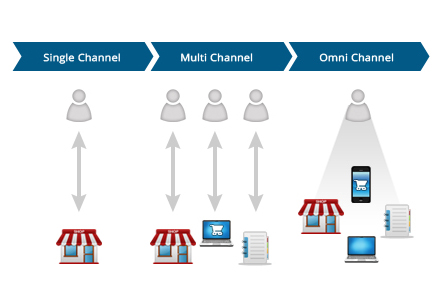Difference between Multi-channel and Omnichannel Commerce
Lets start by defining the two big words.
Multi-channel retailing is the use of a variety of channels in a customer’s shopping experience, including research before a purchase. Such channels include retail stores, online stores, marketplaces, mobile stores, social media stores, mobile app stores, telephone sales and any other method of transacting with a customer. Transacting includes browsing, buying, returning as well as pre and post-sale service.
Omnichannel Retailing is the evolution of multi-channel retailing. It’s about providing a ONE BRAND, ONE EXPERIENCE to consumers across all consumer touch points – mobile internet devices, computers, brick-and-mortar, television, radio, direct mail, catalogue and so on.
There is a fundamental difference between Multi-channel and omnichannel commerce. Unlike multi-channel, omnichannel interactions are not siloed but integrated and absolutely connected to each other to provide a rich customer experience. The experience is seamless, consistent and relevant across all channels and devices of interaction so that a customer can transition from one channel to another freely, without any change in the interaction.
Difference between Multi-channel and Omnichannel commerce
What is the Need for Omnichannel?
From microwaves to smartphones, technology has evolved over the years to provide immediacy. In the 21st century, psychologists worry that our intricately connected lifestyle is making us more impatient. Hence, for our increasingly impatient and fickle customers, the fluidity between channels is a must. Eg: When a shirt is bought from the mall, the customer will have to drive back to the store to return it; it cannot be returned online. However, with omnichannel commerce, the idea is to give the customer the ability to finish a transaction from any chosen channel.
A customer will move to another communication channel if unsatisfied with the prior 75% of the time according to a Forrester report. Today, customers don’t just want to shift channels, they want to shift channels and continue the same conversation with a brand. Today’s customers want what they want, where they want and how they want! This is why omnichannel should be a priority for brands.
What Makes an Omnichannel Retailer?
Generally, an omnichannel retailer will extend his/her traditional storefront with virtual retail channels to gain an ROI on the current investment in real estate, personnel, supply chains, merchandise, etc. Online channels do not only exist as points of sales but also important knowledge portals for consumers. Being a product knowledge hub serves as an advantage to the company where a community is created around the brand, which will eventually translate into sales. Virtual channels, present to convert pre-shoppers to walk-ins and online sales, also are influential in engaging customers and being cost effective to the company.
